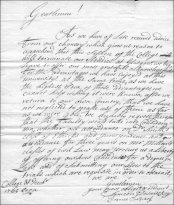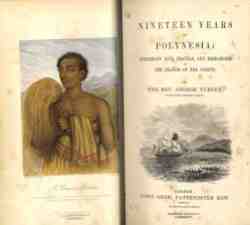With the Baton arriving today (11.03.2014) at Trinidad & Tobago, we have selected to feature the Reverend Alexander Kennedy as one of the University of Glasgow’s earliest, and most interesting, links with Trinidad and Tobago. A devoted and conscientious Christian missionary he possessed an energetic and enterprising character, becoming a prominent and well regarded figure on the island.

Portrait of Kennedy in Port of Spain (in Franklin, After Many Days)
Born in Ayrshire, Kennedy laboured on his father’s farm before deciding to become a missionary. Showing early signs of a strong-willed personality, he would travel daily to study at the University of Glasgow and also the University of Edinburgh, in the winter, while continuing to work on the farm in summer. Kennedy undertook an Arts course at the University, where in 1827 he was matriculated in the Greek class of Daniel K Sandford, in advance of ministerial training. After completing his ministerial training at the Theological College of the United Presbyterian Church he was ordained in 1835 at the presbytery in Glasgow. He was sent to Trinidad, almost immediately, arriving on the island in early 1836, settling in Port-of-Spain. Although the Roman Catholic Church had already established a presence on the island, Kennedy was the first Presbyterian minister to preach there.
Kennedy’s resourcefulness manifested itself in his establishment of the Presbyterian church on Trinidad. Initially, the church agreed to share space in the Wesleyan Methodist Chapel to worship; later renting a disused theatre. In 1837 Kennedy announced plans to build a Presbyterian church, selecting the location and sourcing funds from colonists on the island and from sponsors in Glasgow. Greyfriars church, which took its name from Kennedy’s church in Glasgow, was completed and opened as a place of worship in January 1838.
Continually active in the community Kennedy, and the church, were involved in a variety of projects during his time in Trinidad. A Sabbath school and weekly prayer meetings were established; Greyfriars Congregational Library was founded at a time when there was no public library on the island; the church donated 100 dollars to help those affected by the earthquake in Guadeloupe in 1843; Kennedy personally provided refuge for Portuguese refugees who fled from Madeira, on account of persecution for their Protestant faith; he also regularly contributed to the Trinidadian press writing columns for the Trinidad Spectator and The Trinidadian; furthermore he taught at the first public school inaugurated by Sir Ralph Woodford on the island.
Kennedy was a fervent opponent of slavery: advocating equal rights and criticising the apprenticeship terms imposed after the Abolition Act in 1833. He never shirked his beliefs in the face of criticism or temptation. His commitment and sympathy with the Black population is evident as Kennedy would rise early on the Sabbath and travel to the country side to preach to free Blacks before fulfilling his duties as minister of Greyfriars. On 1 August 1838 – when the first of the apprenticeship terms were officially concluded – Kennedy made direct reference to this, quoting Exodus: ‘Remember this day in which ye came from Egypt out of the house of bondage’ during a sermon. The service was viewed as inflammatory, by some, and he was accused of trying to create tension between the recently emancipated slaves and their future employers. Despite such censure, and some planters’ attempts to win his support he never abandoned his principles and denounced their efforts. He maintained a sympathetic ear to the plight of the Black population and according to his biographer, C. B. Franklin, he was reported to have claimed that once, he was governor of the island, for twenty-four hours, when he prevented a planned revolt on account of his good relationship with them.

Portrait of Kennedy in Canada (in Franklin, After Many Days)
In 1850 Kennedy decided to return to Scotland due to ill health, but visiting Canada his health improved and he chose to settle there. He continued to work as a minister and participate in public matters supporting the temperance movement and involving himself in the debate over the Clergy Reserves in Canada. He died in Welland, Ontario on 19 January 1892, 87 years old.
Greyfriars church still exists today, located on Frederick Street, in the centre of Port of Spain, overlooking Woodford Square. Perhaps a fitting monument to one of Glasgow’s most admirable and assiduous students.
By Peter Strang, PGDip Russian, Commonwealth Caribbean: Trinidad and Tobago , Club21
Sources
W Innes Addison, The Matriculation Albums of the University of Glasgow from 1728 to 1858 (Glasgow, 1913), p. 363
Biography of Kennedy by C. B. Franklin, After Many Days, (Port-of-Spain: Greyfriars Church, 1910) https://archive.org/details/aftermanydaysmem00fran
History of Church of Scotland in Trinidad & Tobago http://www.trinidadandtobagofamilyhistory.org/churchofscotlana.html





















